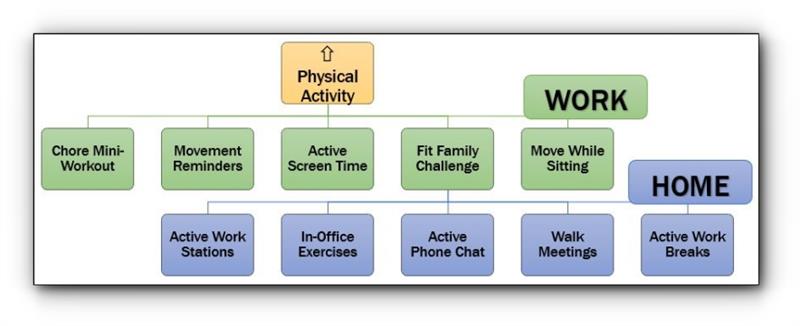
Many of our daily routines have been restricted or modified over the past year during the coronavirus pandemic. It can be difficult to find the motivation and the time to exercise. It is no longer just the “Freshman 15” but now many are experiencing the “Quarantine 15″ which grew to the “COVID 19.” People are recognizing this growing problem and the weight gain was not a surprise. With gyms closed, groceries delivered, and anxiety high, it has been easy to lounge around and comfort eat.
For those of us who work from home, Zoom meetings keep us stuck at our desks and gone are the impromptu walks around the building or the daily walk to and from the car and the office door. You may also be missing the camaraderie of the gym, the relaxation of swimming laps, or the social connection from walking or hiking with a group of friends. If you were used to attending a fitness class in-person with a motivating instructor, it may be hard to keep up the intensity at home or even show up for a workout.
Finding time to exercise or maintaining an exercise routine at home can seem more like a chore than something we want to do. Instead of thinking about making time for a full workout, we can begin to shift our intention and think more about simply finding time to move. Adding more movement, even a short burst, into our day is a lot less intimidating than a full workout and can actually be much more doable than you think. When you start simple, the habit of additional movement can start to be a part of your daily or weekly routine. Once you make a few small changes, you’ll see how easy it is to feel that much more energized during your day. It can be helpful to look for ways to maximize movement instead of minimizing it. Even if it’s just getting outside for a short walk, you will experience benefits.
Exercise is one of the most powerful tools we have for staying physically and mentally healthy.
Benefits of Movement
- Eases stress, depression, and anxiety
- Aids in the management of chronic conditions, such as high blood pressure and diabetes
- Enhances creativity and problem-solving skills
- Boost mood
- Improves cognition and memory
- Restores attention and focus
- Strengthens immune system
- Helps you fall asleep faster and sleep deeper
Your Next Step
Make an exercise plan and prioritize your workouts. People who put their fitness activities on the same calendar as their regular appointments tend to stick to their plan. Start gradually if you’ve been inactive for a long time or you’re trying something new. Emphasize progress and consistency.
Be specific in your goals and track your workouts. Instead of saying you will “get in better shape,” set a concrete goal such as “walk for 30 minutes after work Monday/Wednesday/Friday/Saturday.” You can try one of the many fitness trackers or smartphone apps to help you keep a record of your progress and motivate you to stay on track. Tracking your progress can help keep you accountable, provide a sense of accomplishment, and encourage you to keep going.
Find a form of exercise or movement you enjoy. It is much easier to keep up an exercise routine when you also have fun doing it. Explore these ideas:
- Get outside. Fresh air and sunshine will provide a further boost to your mood. Immerse yourself in the full experience of being outdoors by adding a mindfulness element. Get outside in your garden and tackle some yard work.
- Keep your workouts interesting. Go to a new neighborhood. Find a new instructor or type of workout online. Workout while watching your favorite show or listening to a podcast. Do some wall-sits while reading a book or walk during a phone call.
- Join the kids. Have fun and play catch or tag, go for a bike ride, shoot some baskets, or learn how to play “floor is lava” at a nearby park.
- Create a home workout area. If you have space available, designate an inviting of your home to exercise and keep equipment handy. Try using resistance bands, water bottles, or your own bodyweight to perform resistance exercises. Stair climbing is an efficient strength training exercise.
- S T R E T C H. Making time to stretch and breathe deeply can help balance out the issues of sitting in a chair all day. Place your hands behind your head to strengthen your neck and open up your chest after hunching over a computer or book for hours at a time. Rolling your ankles will increase circulation and tilting your head from side-to-side can release tension in your neck and shoulders.
Creative Ways to Incorporate Movement Breaks

Making time for movement is a lifestyle choice rather than a designated event. Getting up every 30 minutes for a quick bout of activity can add up over the day. If you feel your motivation to move start to decline, remind yourself how much better you will feel after you have moved your body. Being active is one of the best things you can do for your mind and body.
April is Move More Month
It is a great time to get up and move! Created by the American Heart Association as a way to help improve the health of Americans everywhere, National Move Month is aimed at getting more of us to hit 10,000 steps every day or, even better, to hit that 20-minutes of aerobic exercise mark daily.
If you need advice on starting a new activity program, you can make an appointment for a one-on-one consultation with Mary. You can also join Mary online for a livestream class, workout to a video on-demand, or sample a class on her Mary McCarthy Yoga YouTube channel.
Mary McCarthy is a Certified Health and Fitness Instructor with The American College of Sports Medicine and an E-RYT 500 yoga instructor with Yoga Alliance.
Additional resources provided by the American College of Sports Medicine:

